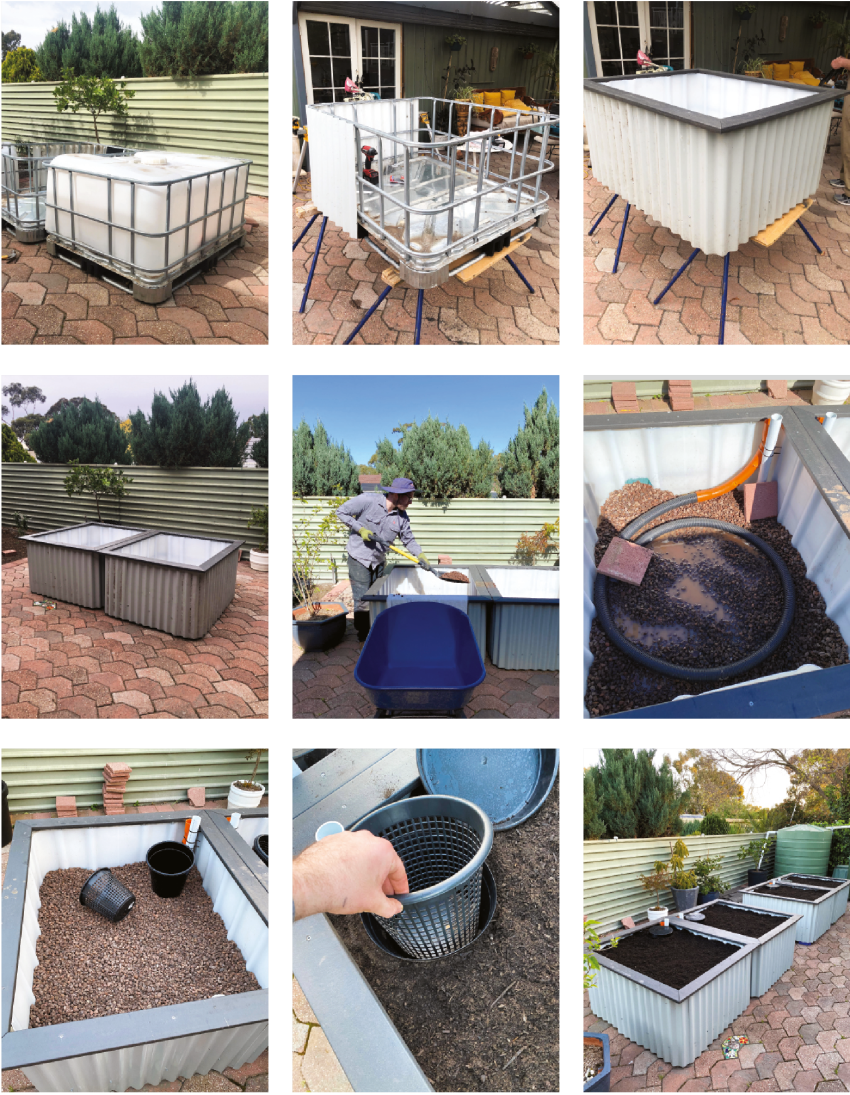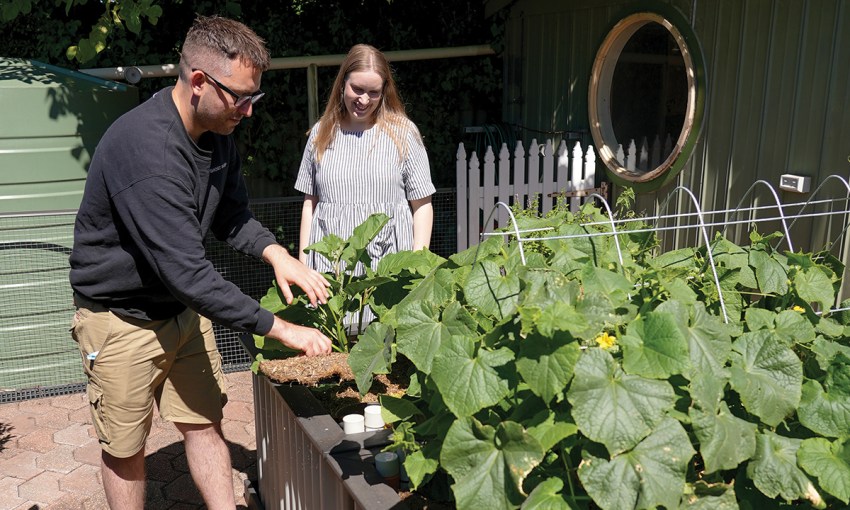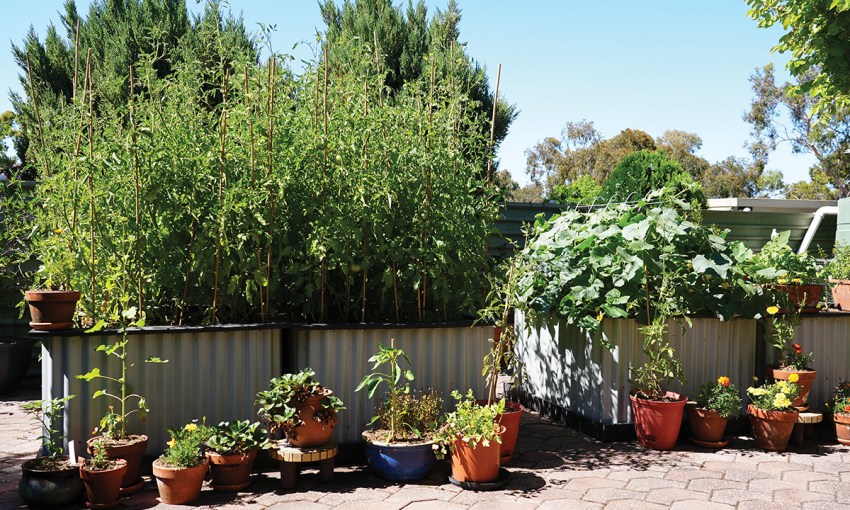Wicking beds are a practical and environmentally friendly way to ensure your veggies are getting just the right amount of water for the maximum crops.
How to build a wicking bed
For anyone whose plants struggle because you forget to water them or because they are continually battling with robbing tree roots or your yard is a barren hardscape, there’s a solution: wicking beds.
Using capillary action to draw moisture up to plants’ roots, wicking beds are the perfect water-smart growing system – especially in a state such as South Australia that really understands and values this precious commodity.
Rather than irrigating from the top, where inconsistent applications, run off and evaporation can severely restrict moisture from finding its way to plant roots, wicking beds do the opposite.
Within the raised bed, a reservoir of water sits under the soil, and moisture naturally works its way upwards. The benefits being that plants thrive and water is delivered in the most efficient way.
Wick gardening is not new, with evidence of capillary action production dating back around 2500 years in the Middle East. However, a clever wicking system devised by Colin Austin – an Australian engineer with a passion for using water efficiently and effectively – is now allowing home gardeners to successfully have a go at constructing their own wicking beds.
When choosing containers to use as wicking beds, look for something around 40-60cm deep, which allows for a 20-30cm water reservoir and 20-40cm of soil. Width is not a major issue, beds can be round, square, rectangular, or any funky shape.
They just need to be water-tight, either by being fully sealed or having a waterproof liner fitted.
Wicking beds incorporate a number of layers, starting with a water reservoir at the base. This consists of a length of slotted agricultural pipe that snakes across the bottom.
A piece of PVC piping, connected to the slotted ag pipe, sticks up at the top of the bed and is where water is poured to fill the reservoir.
To prevent the whole bed from becoming a muddy pond, adding an open tap or port near the base makes sure excess can be drained away.
Attaching an elbow on the overflow tap with a piece of poly pipe sitting vertically, cut to match the internal scoria or sand height, ensures any excess water caused by rainfall can also drain away, preventing waterlogging of the soil above.
By turning the poly pipe horizontally, the reservoir can be drained, or the nutrient-rich water captured for use in other parts of the garden.

Add a thin layer of scoria or washed sand before placing the ag pipe in, then cover with around 20-30cm of the same. This substrate helps move and draw water upwards and around while also preventing the pipe being crushed due to the weight of soil to be added above.
Place a layer of geotextile on top of the substrate to stop this and the soil mixing.
A premium potting mix is ideal for filling the rest of the bed. Landscape suppliers also sell a raised garden mix which works well, and adding coir will further improve the water holding capacity.
Soil depth between 20-40cm allows for efficient capillary action and even watering. Too deep and plant roots struggle to access moisture.
Wet the soil and fill the reservoir, stopping when water runs from the overflow pipe. Depending on the soil moisture level, new plants may need a few top waterings to get started, then they will access all they need from below.
Check the reservoir level every few days over summer and top up as needed. A thick layer of mulch will ensure that water drawn to the surface is not lost to evaporation.
Hannah Cordingley and Branko Lipovac have recently started their wicking bed journey with great success. Like a wave of new home gardeners, they are committed to producing as much organic, home-grown fruit and vegetables as they possibly can.
Running busy lives – especially Hannah who has started a new online business, Jungle Cat Club (@junglecatclub), creating unique jungle-inspired soft furnishings – they were both frustrated at the mixed results achieved when growing veggies in the ground and in raised garden beds.

After much research (there’s plenty of advice available online) and attending a wicking bed workshop, Branko felt ready to tackle the job of building the bed.
A food-grade 500-litre intermediate bulk container (IBC) with its thick plastic walls and surrounding metal cage was the perfect vessel. These 1000-litre IBCs can be cut in half to give two beds and added value.
As filled wicking beds are very heavy, siting them in their final spot from the start is a good idea! Another option is placing them on a plastic pallet, which won’t rot, making the hiring of a palette jack to relocate the beds, if needed, a future possibility.
Removing the plastic insert and cutting off the top gave Branko the chance to clad the open metal frame with corrugated iron, hiding the plastic pallet and totally transforming the raised bed’s look and garden appeal.
After dropping the plastic tub back in, adding an overflow tap and screwing capping around the rim, Hannah and Branko laid in the slotted ag pipe, plus an additional vertical pipe which, using a garden stake as a dip stick, can be used to check the reservoir water height.
Then came the scoria, a geotextile layer and plenty of organic rich soil to top off.
The addition of a few handfuls of tiger worms and a submerged basket in each wicking bed was a very clever way to add a worm farm element and a brilliant solution to provide free plant nutrients from readily available kitchen scraps.
After 12 months, Hannah and Branko are harvesting a bounty of tomatoes, cucumbers, eggplants and a whole lot more, all picked from their four incredibly productive wicking beds.
Wicking beds are a super-smart water and time-saving way to grow. Have a go at making your own!
This article first appeared in the Autumn 2022 issue of SALIFE Gardens & Outdoor magazine.



